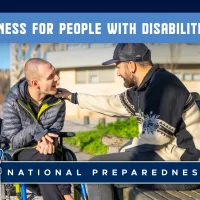
Oregonians are experiencing more frequent wildfires, floods, heat domes, high winds, and ice and snowstorms on an annual basis. These events, fueled by climate change and coupled with the ever-present threat of a Cascadia Subduction Zone earthquake and tsunami, underscore the need for people to be ready for such disasters. September’s National Preparedness Month raises awareness about planning for the unexpected before it happens.
“Disasters can happen anywhere without warning, so it’s imperative Oregonians take active steps to prepare in advance,” said Oregon Department of Emergency Management (ODEM) Interim Director Matt Garrett. “Sit down with your household and talk about what you’d do if you lost electricity, water, internet and phone service for weeks – that’s how long it could take for help to reach you if transportation routes are blocked. Being prepared helps ensure you and your loved ones can survive.”
ODEM urges every Oregonian to practice preparedness by having an emergency plan and enough food, water and necessary supplies for everyone in the household, including pets, to survive for at least two weeks following any large-scale disaster. While this might seem overwhelming, there are many effective low-cost and no-cost actions people can take today to be ready for tomorrow.
Be Informed
- Visit ORAlert.gov to sign up or update your contact information to receive local emergency alerts.
- Enable Wireless Emergency Alerts (WEA) on your mobile phone.
- Understand Oregon’s evacuation levels and know the evacuation routes in your area.
- Find the websites for your county emergency management, sheriff’s office, or tribal police and follow them on social media to stay up to date during quickly changing emergencies.
Have a Plan
- Develop an emergency plan that covers sheltering, evacuating, communicating and reconnecting.
- Plan for pets and livestock.
- Talk to your neighbors about sharing supplies and who might need extra help.
Build a Kit
- Gather two weeks’ worth of food, water and critical supplies for each person and pet, including food, water, medication, flashlights, extra batteries, phone chargers and more. Visit ready.gov or the American Red Cross for recommended emergency kit items.
- Make copies of important documents you’d need to get your life back on track after a disaster; scan or take photos of this information and store it in a password-protected online drive or on a flash drive in a waterproof container and keep it with your emergency kit.
- Keep your supplies in an easy-to-carry backpack, bucket or bag that you can use at home or take with you in an emergency.
- Everyone’s kit will look different. There’s no one correct way to put together two weeks’ worth of supplies since everyone has different needs.
ODEM advises older adults, people with disabilities and caregivers to consider individual circumstances and specific needs when planning for emergencies and create a support network of people who can help during a disaster.
ODEM is partnering with several local, state and federal partners to message National Preparedness Month throughout September. Learn more about National Preparedness Month at oregon.gov/oem and ready.gov.















